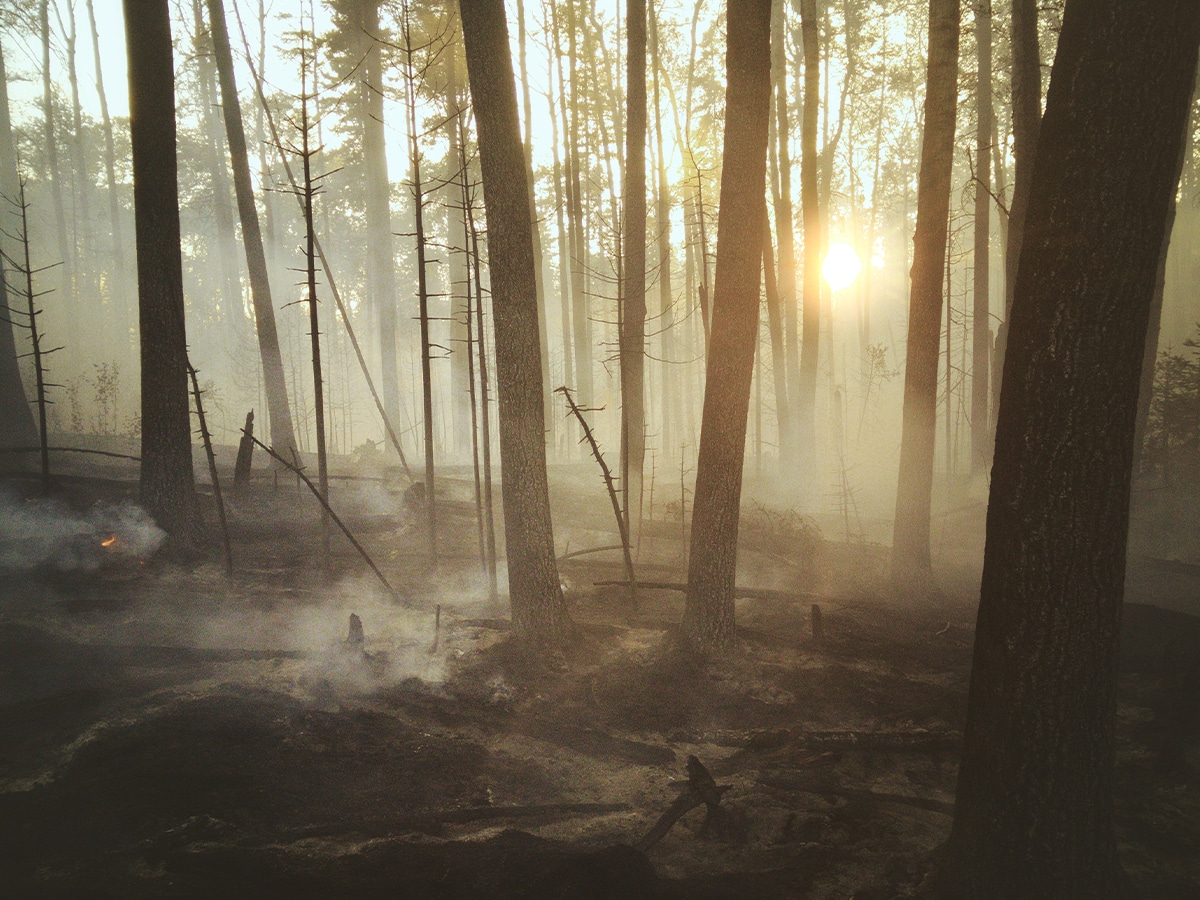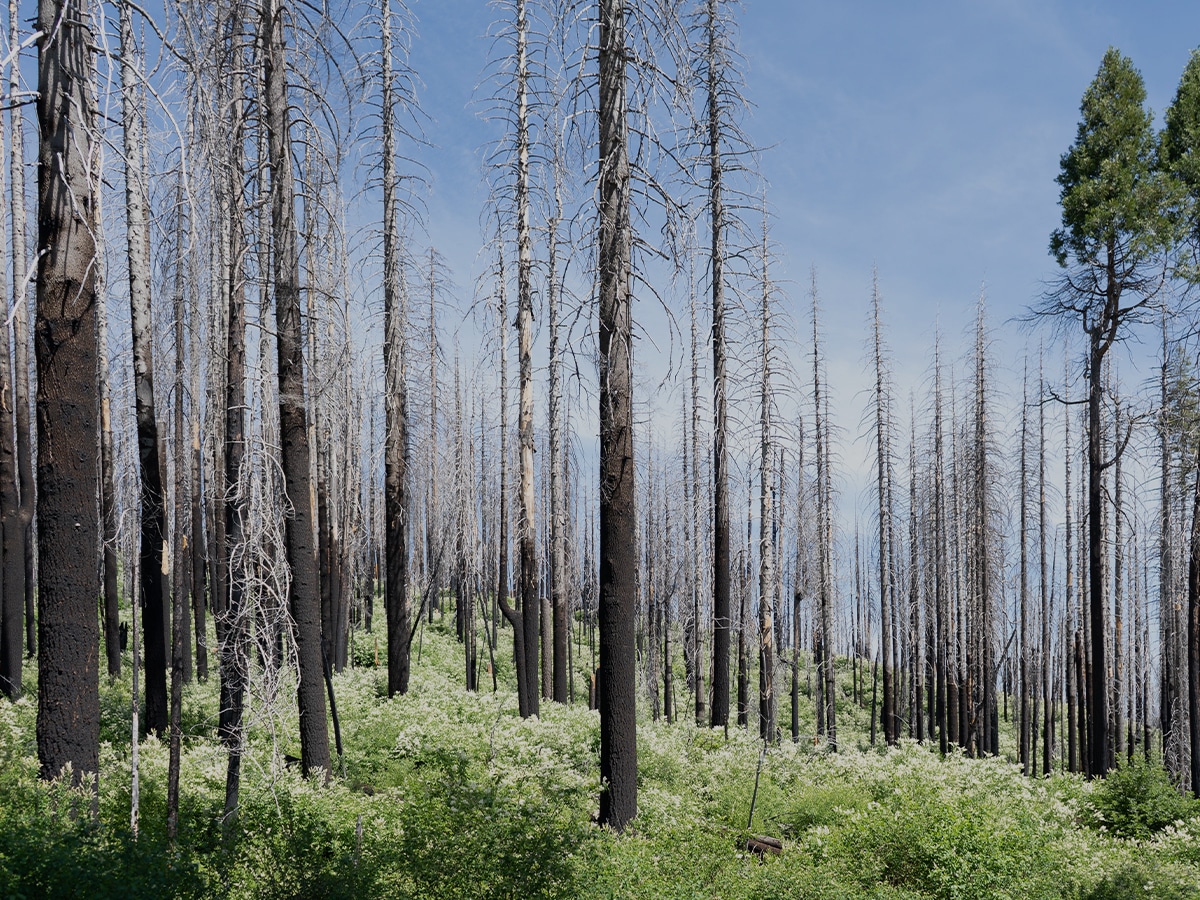Making Connections: Experiencing Wildfire Impacts on the Landscape
Have you ever walked through a burn scar? If you’ve hiked out West, more than likely your answer is yes—even if you don’t realize it. You may have walked past trees with subtle burn scarring at their bases or walked over burnt leaf and needle litter that you wouldn’t have noticed unless you stuck your face in the dirt. On the contrary, if you’ve ever hiked through an area that burned hot and fast, then it would have been difficult to ignore the skeletal, blackened trees that remain when a fire wipes out a landscape from the soil up to the canopy.
Hiking season is here and with two of the last three fire seasons burning a record number of acres in the Western U.S., the chance of your upcoming hike having been recently impacted by fire is high. And whether a place burned 30 years ago or last summer, there’s a ton we can all learn by walking through burnt landscapes and paying attention to the ways fire interacted with the land.

The Ecological Importance of Fire
While haunting, forests recently impacted by fire can be beautiful and productive as hiking, hunting, and foraging locations. For just a few examples, morel mushrooms flourish in areas that have recently burned, and elk and deer will return to even the most blackened areas as soon as there’s new, green growth to eat (sometimes within a year of a fire). Light undergrowth allows these larger animals more ease of movement, while fire also introduces critical nutrients to the soil, things like nitrogen and phosphorous, which encourage plant and algae growth and contribute to more insect life, amongst other things. The ripple effect from there is remarkable—bigger insects and more robust plant life mean larger fish and animals and a healthier ecosystem from the microorganisms to the largest predators and oldest trees.
Fire is at its best when it burns at a low to moderate intensity—meaning it burns along the forest floor, eating up leaves and needles and small brush or trees but rarely getting into the canopies of mature trees. Most of the fires in the West burn at this intensity, and these types of fires are a critical ecological process that healthy forests require. In fact, humans have used fire for millennia for its innumerable benefits, and I would be remiss in not mentioning the extraordinary presence fire had in Indigenous cultures across the West and the world.
Under Indigenous burning practices, many of the West’s landscapes actually burned much more frequently than they do now—the big difference being that they were allowed to burn and purposefully burned so frequently that high-severity fires that would decimate entire swaths of forests were relatively rare. Indigenous peoples have long known that developing a connection to fire—from understanding the way it moves through the land to using it as a tool to perceiving it not as scary but as deeply beneficial—is an essential ingredient of being responsible stewards of the land. This philosophy and the practice of cultural burning was nearly wiped out when it was outlawed by European colonizers in the 1800s, but has had a recent resurgence because of the teachings of generations of tribal members. Tribal peoples understand the importance of being active participants in their landscapes, their human presence so tightly wound into the fabric of the landscape so as to be very much a part of it. In order to create a more positive relationship with fire and, ultimately, reduce disastrous fires, modern humans will need to relearn this essential philosophy.
Wildfires are, after all, as much a part of the landscapes we love and recreate in as the elk, the black bear, the balsamroot, or the ponderosa pines. And while fires are growing more and more ubiquitous as the climate warms and our forests grow increasingly drought-ridden, fire impacts on your favorite backpacking or hiking spots don’t have to be depressing or even a reason to cancel your trip. Getting out to enjoy an area after a burn can be an enjoyable, educational, and unique experience and might even make you want to develop that deeper connection to fire and how it affects the lands you love.

Experiencing a Burn Scar: What to Look For
A good way to build that connection is to simply understand the myriad ways that fires are immensely beneficial—without them, forests become overgrown, unhealthy, drought ridden, and more susceptible to bug kill. Sound familiar? That describes a vast majority of the land and forests in the West right now. The real kicker is that unhealthy forests burn more severely than healthy forests—and the vicious cycle continues.
Fire can be an overwhelmingly positive presence on the landscape, though, and only really becomes problematic when it coalesces with human settlement and critical infrastructure or, at the worst, threatens lives or livelihoods. But the majority of fire in the West—some 98 percent, in fact—is ecologically beneficial and doesn’t impact humanity beyond producing smoke. Many of these fires burn in the middle of nowhere, far away from roads, homeowners, and TV cameras—but often adjacent to places where humans like to recreate. It’s in these spaces where we can learn about fire and its many benefits.
Imagine you’re walking through a burn scar, perhaps one from three years ago. By now, you’ll likely see a sea of green on the forest floor, shooting up from black soil that is partially hidden by leaves and pine needles. You may notice that the bottoms of the trees are covered in ash, which could rub off on your skin or clothes if you brush up against it. It’s fun to spend some time looking at trees that are burnt at their bases—look around and see if other trees have the same scars (evidence of at least a small wildfire) or if this one tree may have been the sole victim of a lightning strike. Note how far up the ash extends; this is a good indication of what kind of vegetation once inhabited this area, as higher burn scars indicate higher and denser vegetation. Did the fire get into the canopies of the trees around you? Are there trees that are blackened all the way up with no remaining limbs or with limbs that are severely burnt? That’s a good indication of a high-intensity fire.
As you walk through a burn scar, you may notice that fire burns in a “mosaic” pattern that leaves some islands of trees and brush untouched while others are scorched deep into the soil. Fires naturally burn in a mosaic pattern based on the density of the vegetation, the wind, the topography of the area, or what aspect it burned at—this creates a broad mix of different burns from different years that all burned at different intensities across the entire landscape, which is exactly what makes an area healthy and alluring to animals from the bottom to the top of the food chain.
It may be surprising, but even high-severity fires that leave skeletal trees are a natural process that have a historical precedent in pre-colonial times. These types of fire scars are jarring yet beautiful in their starkness—and a good example of what is to come if the climate continues to warm and we continue to see extreme weather and drought patterns in the West. While these types of fire are an altogether healthy part of the landscape—even if they don’t look the part—they are only beneficial in moderation.

Considerations While Exploring Burn Scars
Wildfires can create some real beauty: the starkness of a landscape in the years following a fire, the regrowth of huckleberries, morel mushrooms, and a wide range of wildflowers in the aftermath and the massive views that can result from the removal of underbrush and small trees are all good reasons to seek out fire scars for outings this summer.
But they can also be pretty eerie places and can be dangerous for decades after they burn. With high-severity fire, you have to consider the erosion that results from incinerated soils that are no longer held together by root systems. This can result in mudslides or flooding during rain events and should be considered before hiking in any recently burned area. In any fire scar, you also need to consider weakened trees with burnt out roots; falling trees should be your biggest concern when walking through a burn scar, though there’s a good chance that if the trail you’re navigating is open, then a trail or fire crew likely already went through and cut a majority of the problematic trees. Still, veering off the trail for any reason could put you in the path of a weakened tree, and adding wind to this equation could be a recipe for an injury or worse.
Keeping your head up, constantly assessing your surroundings, not setting your tent up under fire-weakened trees, and ensuring that there will be little or no wind before you leave are all great ways to avoid an accident. Another critical step would be to reach out to whatever land agency or national forest is responsible for the trail to ensure that it is open and safe.
Additionally, you should be wary of any “stump holes,” or the holes that remain after a stump and its root system burns out. These can be hidden by brush or leaf litter, but it’d be smart to bring a hiking pole to poke the ground ahead of you when going off trail in burn scars. A wrong step into a stump hole could be painful or, at worst, lead to an injury.
Once you’ve considered and mitigated these potential dangers and ensured that an area or trail is open for hiking, walking through these places can be a unique way to experience a landscape in a new way, and to take a critical look at how fire interacts with different landscapes, vegetation types, and aspects. There are few other opportunities to see the impacts of wildfire while you actively experience a place—and this could be the critical first step towards deepening your own relationship with the land and understanding fire’s place within it.